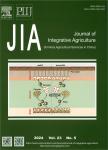Recognizing production options for pearl millet in Pakistan under changing climate scenarios
Recognizing production options for pearl millet in Pakistan under changing climate scenarios作者机构:Agro-climatology Laboratory Department of Agronomy University of Agriculture Faisalabad 38040 Pakistan Directorate of Agronomy Ayub Agricultural Research Institute (AARI) Faisalabad 38850 Pakistan Institute of Soil and Environmental Sciences University of Agriculture Faisalabad 38040 Pakistan
出 版 物:《Journal of Integrative Agriculture》 (农业科学学报(英文版))
年 卷 期:2017年第16卷第4期
页 面:762-773页
核心收录:
学科分类:07[理学] 070601[理学-气象学] 09[农学] 0706[理学-大气科学] 0901[农学-作物学]
基 金:the authors acknowledge government of the punjab agriculture department lahore and ayub agricultural research institute (aari) faisalabad pakistan for giving opportunity through nomination for phd studies at university of agriculture faisalabad pakistan. heartfelt thanks go to prof. abid hussain department of agronomy university of agriculture faisalabad pakistan who always convinced and guided us to focus on recent advances in agronomy. his support towards planning phd thesis research is adorable
主 题:pearl millet production options climate change nitrogen use efficiency radiation use efficiency
摘 要:Climate change is making the lands a harsher environment all over the world including Pakistan. It is expected to oppose us with three main challenges: increase in temperature up to 2-5℃ (heat stress), increasing water stress and severe malnourishment due to climate change. It has been foreseen that there will be a 10% increase of dryland areas with climate change in the world, with more variability and incidences of short periods of extreme events (drought and heat stress). Pearl millet is a hardy, climate smart grain crop, idyllic for environments prone to drought and heat stresses. The crop continues to produce highly nutritious grain sustainably, thereby encouraging the fight against poverty and food insecurity due to its resilience. The crop is more responsive to good production options (planting time, planting density, inter/intra row spacing, nitrogen application and irrigation). It has high crop growth rate, large leaf area index and high radiation use efficiency that confers its high potential yield. In most of the cases, pearl millet is remained our agricultural answer to the climate calamity that we are facing, because it is selected as water saving, drought tolerant and climate change complaint crop. In view of circumstances, pearl millet cultivation must be retrieved by recognizing production options in context to changing climate scenarios of Pakistan using crop modeling techniques.



